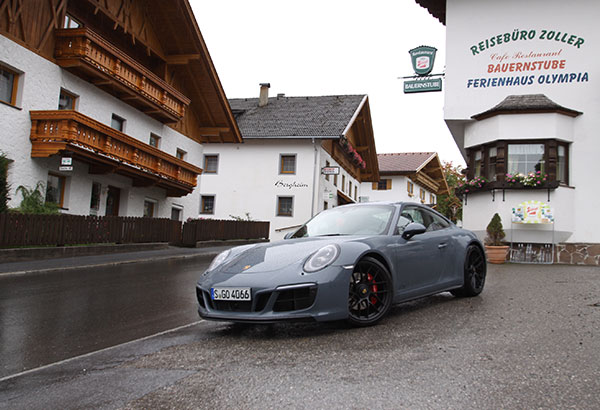Three countries and a Carrera

Conquering the Autobahn and the Alps from behind the wheel
Sunlight pushes fingers to touch the earth past dark thunderheads. It’s a welcome promise of the rain letting up on what could be a beautiful day. Fixated on the arresting landscape of never-ending open road and sky makes us forget the immense velocity by which we traverse this autobahn.
About an hour since departing from Stuttgart, I am able to glance at the speedometer as it breaches 200kph. The car remains steady, continuing to surge forward with eager compliance to the accelerator. At 264kph, a slower-moving car (at this rate, every vehicle on the road is one) intrudes into the overtaking lane, and I step on the brakes. The car briefly twitches on the wet road as if jolted out of its reverie, then goes about its business of outmuscling every car on the road on our way to Timmelsjoch in Austria.
This is the Porsche 911 Carrera 4 GTS.
With an aft-mounted six-cylinder twin-turbo engine, this 911’s loud bark and beautiful profile are matched by output numbers to sweep aside all posers. The 3.0-liter heart pumps out 450hp and 550Nm – delivering performance worthy of the iconic nameplate.
Our three-Porsche party is composed of our 911 C4, a 911 Targa 4 GTS (with a power plant similar to ours), and a larger Panamera 4 e-Hybrid. We had picked up the trio of vehicles straight from Porsche’s historic Zuffenhausen plant where all the brand’s two-door coupes are made (the Panamera, Macan, and Cayenne are assembled at Leipzig).
Zuffenhausen is among Stuttgart’s northernmost districts and is known as one of the oldest continuously inhabited places in Stuttgart, with evidence of permanent settlements as early as 7,500 years ago.
These days, the so-called “brick building” or “backsteinbau” seems out of place amid the modern structures surrounding, but the red-colored edifice adjacent to the Porsche body plant has been an important part of the carmaker’s history since it was erected in 1938. For one thing, the brick building houses management offices.
The Porscheplatz (or Porsche Square) is Mecca for aficionados of the German sportscar brand. From the Christophorus Restaurant atop the Porsche Museum, one can more thoroughly behold “Inspiration 911,” a sculpture completed in 2015 by British artist Gerry Judah. Three pillars, measuring up to 78 feet in height, are “crowned” with upward-pointed 911s. You can tuck into “Mediterranean and regional delicacies” after an educational, inspiring, and exciting tour of the Porsche Museum – replete with awesome pieces from the brand’s history.
Our all-wheel-drive Carrera’s robust engine is mated to a seven-speed PDK, which shifts quickly and seamlessly. If you wish, take charge via the paddle shifts behind the luscious Alcantara-covered steering wheel.
A whole slew of Porsche technologies assures a safe, yet no less visceral drive if you so desire. This much I have seen at Porsche: Performance doesn’t come at the cost of usability and usefulness. You don’t have to be a professional driver to access the potentials of its vehicles (although you have to be in an appropriate setting, of course).
The electromechanical power-assisted steering (with variable steering ratio and steering pulse generator) provides enough feedback and precise control. Porsche Stability Management (PSM) assures stability even when the vehicle is pushed. The company reports that “sensors continuously monitor the direction, speed, yaw velocity and lateral acceleration of the car. Using this information, PSM is able to calculate the actual direction of travel at any given moment and initiates strategic braking of individual wheels to prevent… (deviation) from (the) intended line.” PSM is able to promise even when “accelerating on inconsistent surfaces,” using an automatic brake differential and anti-slip regulation functions.
Rapidly ingesting pavement, our Graphite Blue Carrera, unlike some sports cars, willingly submits to some stop-and-go traffic as we approach Imst in Austria. It even has an auto stop/start function and coasting (in conjunction with PDK). What is it that they say about having the best of both worlds?
We are welcomed to Timmelsjoch’s by a light but constant snow. After a quick tour of the motorcycle museum (the highest one located in Europe), our convoy pushes through the scenic, postcard-worthy, white-covered Alpine passes. Our 911 remains sure-footed even on the snow, but when the ice starts to appear on the winding road, Porsche Asia Pacific PR executive James Wong suggests we head back as our cars aren’t fitted with the required snow tires.
But not after we come upon a sign saying we have reached the Italian part of the Alps. Yup, three countries in a day aboard a Porsche 911. We are definitely impressed and awed – even if the 911 looks nonplussed and unimpressed itself. In fact, we can almost hear it whisper a desire to go out for more adventure.
- Latest




























